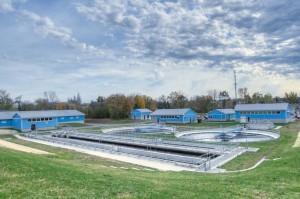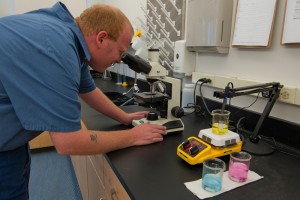New Antioch Plant Addresses Phosphorus Concerns
The Village of Antioch is located in Illinois halfway between Milwaukee and Chicago. This quaint village attracts many tourists with its beautiful lakes, golf courses, and  shopping areas. Given these attributes, it comes as no surprise that Antioch is a thriving community with significant growth anticipated in its future. In 2005, the Village’s population was around 11,500 and over 1,000 new homes were popping up around the area.
shopping areas. Given these attributes, it comes as no surprise that Antioch is a thriving community with significant growth anticipated in its future. In 2005, the Village’s population was around 11,500 and over 1,000 new homes were popping up around the area.
The old wastewater treatment plant (WWTP) consisted of an automatic bar screen, primary clarification, two-stage biological treatment, filtration, and disinfection. Sludge was processed in aerobic digesters and dewatered using a belt filter press. This WWTP serves about 60% of the Village, with the wastewater from the rest of the Village conveyed to a county system. The original plant on the site was built in 1917 and was then upgraded multiple times, most recently in 1992. After this upgrade, the system had generally operated efficiently and continuously met effluent limits, but time was taking its toll on the equipment and the plant needed to address the anticipated population growth of the Village. For these reasons, Antioch hired ATI to create a Facilities Plan.
After comparing the capital costs, operation and maintenance costs, total present worths, and intangible criteria, it was determined that the best alternative for the Village would be building a new plant on the existing site. The plant was sized at 2.0 mgd to serve a population of 15,000 in the year 2025, again for about 60% of the Village. The new WWTP includes the following processes:
- Screening
- Biological nutrient removal
- Final clarifiers
- UV disinfection
- Aerobic digesters
- Sludge dewatering
- Sludge cake storage
Screening
The screening equipment is located in the Headworks Building. The wastewater passes through the screen, and debris larger than ¼ inch is retained on the screen. The automatic screening system processes the debris and deposits it in a dumpster. The material is transported to a landfill for disposal.
Biological Nutrient Removal
The aeration tanks include anaerobic and anoxic cells for the purpose of biological nutrient removal (BNR). This facility is one of the first in Illinois to employ BNR technology. This system provides for biological removal of phosphorus and nitrogen, which are nutrients that can lead to issues in Sequoit Creek and the downstream Lake Marie. The WWTP also includes a chemical system to assist the BNR system in phosphorus control. In the aeration tanks, the wastewater is mixed with a biologically active liquid sludge, and the wastewater and sludge are processed in the various zones of the aeration tanks. The liquid in the aeration tanks is a blend of sludge and water. The next treatment step is to separate the water and sludge, which is accomplished in the final clarifiers.
Final Clarifiers
The final clarifiers provide a calm area where the sludge and the treated water separate under the influence of gravity. The clear water flows over weirs at the top of the tank, and on to the disinfection system. Sludge settles to the bottom of the tank, where it is collected and pumped back to the aeration tanks.
UV Disinfection
The disinfection system employs ultraviolet (UV) light as the disinfection agent. This state-of-the-art disinfection system replaces the old and hazardous chlorine disinfection system that was used at the old plant. The treated wastewater from the final clarifiers passes through the UV disinfection system and is then discharged to Sequoit Creek.
Aerobic Digesters
The treatment plant uses natural processes to remove pollutants from the wastewater. Bacteria and other microorganisms use the pollutants as a food source and produce more microorganisms. The microorganisms and the other solids in the wastewater accumulate as sludge. Excess sludge is removed from the treatment system on a daily basis. The sludge is then further biologically processed in the aerobic digesters. In the digesters, the sludge looks like brown, muddy water.
Sludge Dewatering/Storage
The sludge from the digesters is about 2% solids, or 98% water. The sludge needs to be removed from the treatment plant; however, hauling material that is mostly water is expensive. The new plant has a belt press and related equipment located in the Dewatering Building. This equipment is used to remove 85% to 90% of the water from the sludge. The sludge that remains after processing through the belt press is no longer a liquid, but rather a semi-solid material called sludge cake. The cake is stored in the sludge storage building and is removed two or three times each year. The sludge cake is applied to agricultural fields as a soil amendment.
The plant equipment, including RAS and WAS pumps and aeration blowers, are housed in a new Equipment Building. This building also has a large generator, powered by natural gas, which is intended to provide enough electricity to run the plant during power outages. The Village has taken advantage of the capacity of this generator to change the plant to an “interruptible” power rating with the local power utility. This has provided an electrical rate advantage to the Village, resulting in significant savings.
The WWTP includes a new Administration Building. This building houses the plant laboratory, where daily testing takes place to monitor the plant. The Administration Building also has a large multipurpose room, which functions as a lunch room on a daily basis and is also used as a training room and meeting room when needed. The building includes the plant office spaces and computer connections to the plant Supervisory Control and Data Acquisition (SCADA) system. The SCADA system provides the operator with immediate access to all of the plant monitoring instruments, as well as control of most of the plant equipment.
With its new state-of-the-art facility, the Village of Antioch is ready take on phosphorus and serve its growing population!

Leave a Comment